As the sun blazes overhead and the mercury inches closer to that sweltering 90-degree mark, a pressing question emerges for lawn enthusiasts: Is 90 degrees too hot to mow?
This isn’t just about keeping your grass pristine—it’s about the potential damage to your lawn and, more importantly, the safety concerns associated with working under such intense heat. But, fret not, for you’re not alone in this quandary.
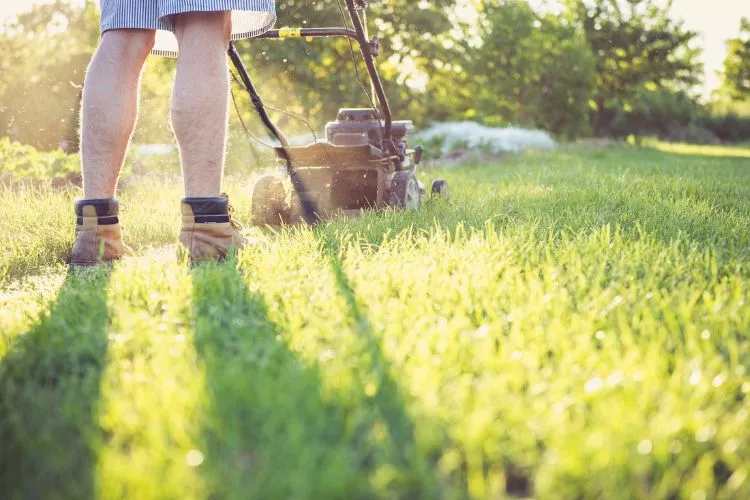
Many homeowners grapple with the challenge of maintaining their lawn’s vitality during the scorching summer months. Addressing these concerns, this article delves deep into the science of grass, temperature effects, and mowing best practices.
By the end, not only will you understand the implications of mowing in high temperatures, but you’ll also be equipped with strategies to keep both your lawn and yourself in top shape. Dive in, and let’s make those summer mowing decisions a breeze!
Table of Contents
Understanding the Impact of Temperature on Lawn Care
Temperature doesn’t just dictate our wardrobe choices or plans for the day—it plays a pivotal role in the world of lawn care. While a sunny day might seem like the perfect time to bring out the mower, it’s crucial to understand how different temperature ranges influence our grass and its overall health.
Before diving into the specifics of mowing at 90 degrees, let’s first lay the groundwork by exploring how temperature, as a variable, intertwines with the vitality, growth, and needs of our beloved green carpets.
The role of temperature in lawn health
Temperature plays a pivotal role in shaping the vitality and appearance of your lawn. But understanding the precise manner in which temperature impacts grass growth is crucial for effective lawn maintenance.
Optimal Temperature Range for Different Grass Types
Just as orchids and cacti have different environmental preferences, so do Bermuda and Fescue. Each grass type has its own comfort zone, an optimal temperature range where it not only survives but thrives. Step outside this range, and you might be setting your lawn up for a difficult time.
For instance:
- Cool-season grasses like Kentucky Bluegrass or Fescue thrive in temperatures between 60-75°F (15-24°C).
- Warm-season grasses such as Bermuda or Zoysia flourish in temperatures from 80-95°F (27-35°C).
Exposing these grasses to temperatures outside their comfort zones can lead to reduced growth and vitality.
Effects of Extreme Heat on Grass
But what happens when we hit those dog days of summer, and the temperature starts pushing boundaries? Extreme heat doesn’t just make us sweat; it affects the very cellular processes of grass, leading to potential damage that can take weeks or even months to repair.
When exposed to prolonged heat, above 90°F (32°C) for cool-season grasses and above 100°F (38°C) for warm-season ones, various adverse effects become evident:
- Discoloration: Grass might turn brown or yellow as it struggles to photosynthesize effectively.
- Wilting: Blades might begin to droop due to dehydration.
- Dormancy: Grass can enter a dormant state to conserve energy and water.
The science behind grass growth and temperature
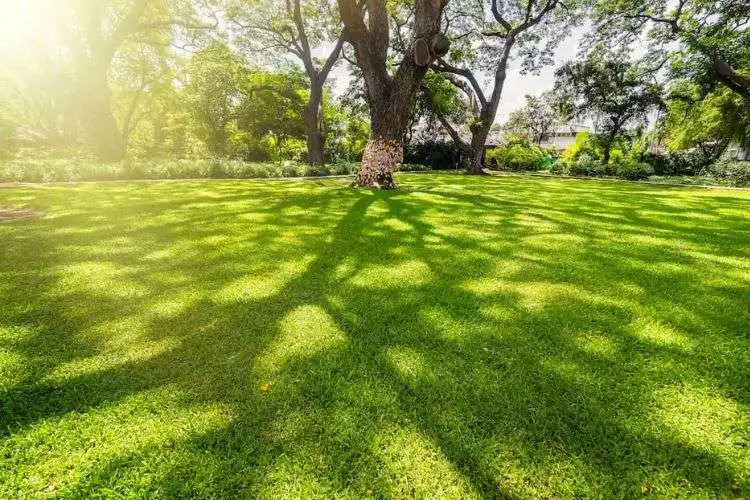
Understanding the nuances of how temperature affects grass growth goes beyond mere observations—it requires delving into the core biological processes that sustain these green blades.
This deep dive not only satiates our scientific curiosity but also aids in making informed lawn care decisions.
Photosynthesis and Temperature
Photosynthesis, the process through which grass converts sunlight into energy, is heavily influenced by temperature. Chlorophyll, the pigment responsible for capturing light, has optimal functioning temperatures:
- Cool-season grasses, such as Kentucky Bluegrass, peak in photosynthetic activity at around 65-75°F (18-24°C).
- Warm-season grasses, like Bermuda, have their peak closer to 85-90°F (29-32°C).
Outside of these ranges, photosynthetic efficiency drops. For example, at temperatures exceeding 95°F (35°C), many grasses experience a decline in energy production, which can lead to slowed growth or even dormancy.
Water Requirements in Hot Weather
Water plays a dual role for grass: it’s vital for metabolic processes and also aids in cooling the plant through transpiration. As temperatures rise:
- A lawn might require up to 50% more water during a heatwave compared to moderate temperatures.
- For instance, if your Kentucky Bluegrass lawn usually requires 1 inch (2.5 cm) of water per week in spring, during a hot summer week with temperatures hovering around 90°F (32°C), it might need 1.5 inches (3.8 cm) or more.
It’s not just about quantity, though. In extreme heat, more frequent watering might be beneficial to prevent the topsoil from drying out completely, even if the total weekly water amount remains unchanged.
How temperature affects your mowing routine
Mowing might seem like a simple, mechanical task. You power up your mower, roll it across the lawn, and voila, you’re left with a neatly trimmed green space.
However, when you introduce varying temperatures into the equation, this routine task can quickly become a complicated affair, with potential consequences for both your lawn’s health and your own.
Why Mowing in Extreme Heat Can Be Challenging
Mowing during extreme heat can spell trouble for several reasons:
- Grass Stress: Just like us, grasses experience stress in intense heat. Cutting them during these periods can exacerbate this stress. For example, a lawn mowed at 95°F (35°C) might show signs of browning or ‘burning’ at the tips, which isn’t just a cosmetic issue – it indicates stress and potential damage at the cellular level.
- Moisture Loss: The act of mowing opens up fresh cuts on grass blades, which can speed up the loss of moisture. On a sweltering day, this can mean your lawn dries out much faster post-mow than it would on a cooler day.
- Equipment Strain: High temperatures don’t just affect your grass; they can also impact your mowing equipment. Engines can overheat, and the efficiency of the blade might diminish in such conditions.
Knowing these challenges doesn’t mean you have to avoid mowing altogether when it’s hot. Instead, it’s about arming yourself with the knowledge to mow smartly, ensuring you’re not unintentionally harming your lawn or equipment in the process.
Is 90 degrees too hot to mow?
The quintessential question every gardener finds themselves asking during the sweltering days of summer. 90°F (32°C) is, undeniably, hot. However, is it categorically too hot for mowing? Well, the answer isn’t as straightforward as a simple ‘yes’ or ‘no’. Several factors come into play, from the type of grass you have to your own personal safety.
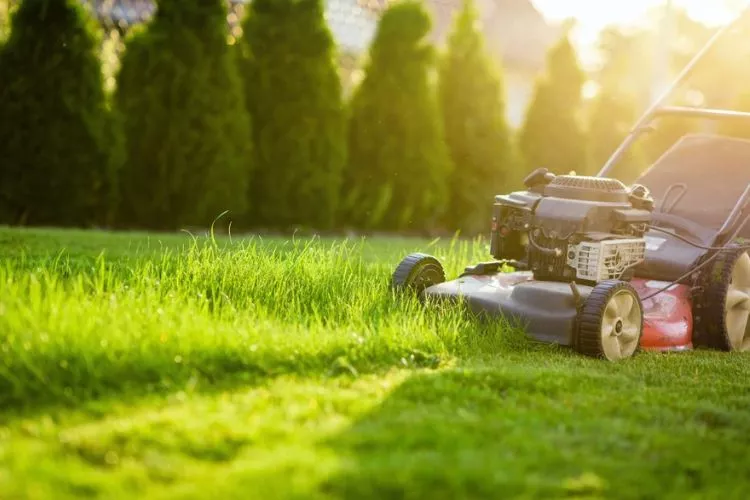
General guidelines
For the majority of grass types, particularly cool-season ones, mowing during 90°F (32°C) heat can be detrimental. Here’s why:
- The heat has already placed your lawn under significant stress. Mowing, which naturally stresses grass due to the cutting of blades and possible uprooting, can amplify this stress.
- There’s a risk of “scalping” the lawn. When grass is hot and possibly a little dehydrated, its blades can be more brittle. A mower can then cut the grass unevenly, leading to patches that look scalped.
Factors to consider
Several variables should influence your decision to mow or not to mow at 90°F (32°C):
- Type of Grass: Warm-season grasses might handle the heat slightly better than cool-season varieties. Bermuda, for example, might fare okay if mowed in the late evening.
- Recent Weather Patterns: If it’s been consistently hot and dry, your lawn might be more vulnerable. Conversely, if there was a recent rainfall, and the soil is moist, mowing might be less damaging.
- Time of Day: It’s generally recommended to mow during the cooler parts of the day, such as early morning or late evening, when considering mowing in extreme heat.
While the thermometer reading is essential, these factors play an equally vital role in determining if it’s safe and beneficial to give your lawn a trim. By keeping these guidelines and considerations in mind, you’ll ensure optimal health for your lawn, even in the face of relentless summer heat.
You may also find useful: How Early Can You Legally Mow Your Lawn? | Can You Mow The Lawn With a Pacemaker?
Signs Your Lawn Might Be Suffering in the Heat
When summer is in full swing, the rising mercury isn’t just a test for us but for our lawns too. While sun-soaked days might be perfect for beach outings or barbecues, they can be punishing for our green patches.
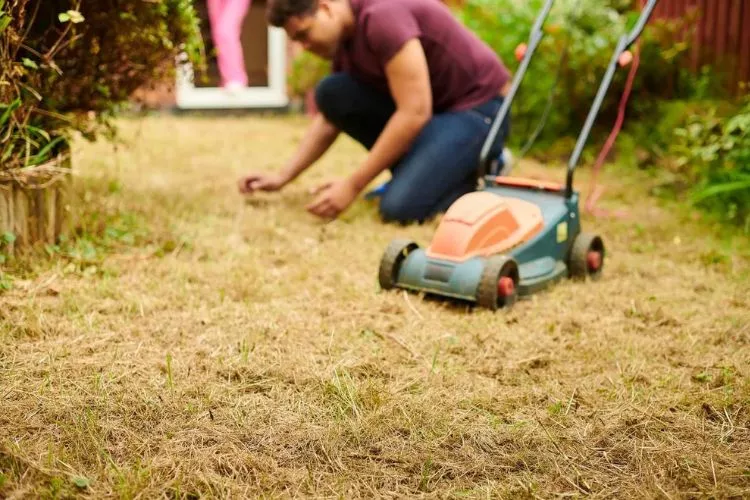
Just like any other living organism, grass responds to environmental stress, and the signs of struggle can often be subtle. Recognizing these tell-tale indicators is the first step to ensuring your lawn remains lush, green, and healthy, even under the sun’s relentless gaze.
Identifying stress symptoms in your grass
Grass, like any other plant, has ways of signaling when it’s in distress. These signs are nature’s SOS, asking for a change in care or attention. Understanding these signals can make the difference between a vibrant lawn and one that’s barely hanging on.
- Discoloration: One of the most obvious signs is a shift in color. Healthy grass usually has a vibrant green hue. Stress from excessive heat can cause the blades to take on a bluish-gray tint. In more severe cases, patches of the lawn may turn brown. For instance, you might notice that a lush Kentucky bluegrass lawn slowly starts to exhibit yellowish or brown patches, signaling dehydration or sunburn.
- Wilting: Grass blades that curl or appear folded are signs that they are wilting under the sun’s heat. A lawn that once stood tall and springy becomes limp, with blades folding inwards. This is the grass’s way of reducing its surface area exposure to the sun and conserving moisture.
- Footprints Staying Visible: On a healthy lawn, when you walk over it, the grass springs back promptly. However, a stressed lawn, especially one lacking moisture, will show footprints or tire tracks that don’t disappear quickly. It’s a clear indication that the lawn’s resilience is compromised.
Knowing when your lawn needs attention
It’s not just about spotting the signs but also about proactive monitoring. After all, preventative care often trumps reactive solutions when it comes to lawn health.
- Setting Up a Regular Inspection Routine: Just as you’d have a routine for house plants, set up a weekly (or even bi-weekly) inspection routine for your lawn. Look out for the early signs of stress we discussed above. This could mean a stroll through your lawn every Sunday morning, feeling the grass with your fingers, and looking for any patches that seem out of the ordinary.
- Monitoring Weather Forecasts: It might sound a tad overboard, but staying updated with weather forecasts can be instrumental. If a heatwave is predicted, you can take pre-emptive measures. For example, if the forecast predicts a week of 90°F (32°C) temperatures, you might want to water your lawn deeply in preparation, ensuring it has enough moisture to endure the upcoming hot days.
Mowing Strategies for Hot Weather
As the sun blazes down and temperatures soar, even the routine task of mowing the lawn demands a rethink. Simply pushing your mower around like it’s a cool spring day won’t cut it—literally and figuratively.
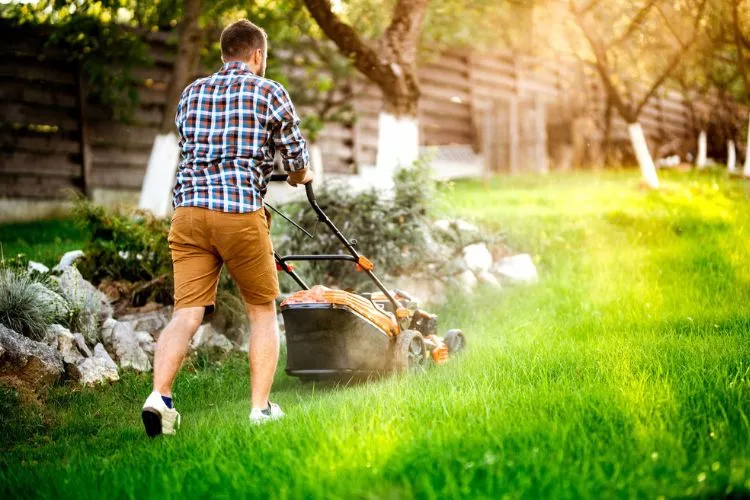
Hot weather poses unique challenges, both for the grass and the person mowing. But fear not, with the right strategies and adjustments, you can ensure your lawn remains in top-notch condition without putting yourself at risk.
This section delves into the meticulous methods and tips you should consider when the mercury rises, ensuring both a healthy lawn and a safe mowing experience.
Choosing the right time to mow
When it’s sweltering outside, timing is everything. The sun’s intensity, humidity levels, and even the dew on the grass can make a huge difference in how effectively and safely you can mow.
Morning vs. Evening Mowing
- Morning: Mowing in the early morning can be ideal. The grass is still dew-laden, which can provide some cooling relief. However, it’s essential to wait until the dew has somewhat lifted. Mowing extremely wet grass can clog your mower and result in uneven cuts. Generally, a couple of hours after sunrise is an optimal window.
- Evening: As the sun begins its descent, and temperatures start to drop, the evening can be another opportune time to mow. The grass has had the entire day to dry out, and there’s less direct sunlight, reducing the stress on both the lawn and the person mowing. Aim for a couple of hours before sunset to give your grass some recovery time before nightfall.
Proper hydration for your lawn
Hydration isn’t just crucial for humans in the heat; your lawn thirsts for it too. Ensuring it receives the right amount of water at the right times is vital for its health and resilience.
Irrigation Guidelines
- Frequency: During scorching periods, watering your lawn every 2-3 days is generally recommended. However, this frequency can vary based on the specific type of grass and the local climate.
- Timing: Watering in the early morning or late evening is ideal. During these times, the water has a better chance to seep deep into the soil before it evaporates, ensuring your grass roots get the hydration they need.
Deep Watering vs. Frequent Shallow Watering
- Deep Watering: This method involves infrequent but deep watering sessions. By allowing water to penetrate deeply into the soil (about 6-8 inches or 15-20 cm), you encourage the grass roots to grow deeper, making them more resilient to drought conditions. It’s advisable to provide about 1-1.5 inches (2.5-3.8 cm) of water during each session.
- Frequent Shallow Watering: This approach involves more regular watering but in lesser quantities. While it might seem like a good way to keep the lawn hydrated, it can lead to shallow root growth. Grass with shallow roots is more susceptible to stress during prolonged hot and dry conditions.
Adjusting the mowing height
The height at which you mow your grass can dramatically influence its ability to withstand the summer heat. Cutting your grass too short might seem like a way to reduce the frequency of mowing, but it can have unintended consequences.

The Importance of Leaving Some Grass Length
- Protection: Taller grass can shield the soil from direct sunlight, reducing evaporation and keeping the soil moist for longer periods. This also aids in preventing the growth of weeds which often require direct sunlight.
- Root Depth: There’s a direct relationship between the height of the grass above the ground and the depth of its roots below. Longer grass generally means deeper roots, allowing the lawn to access water from further below the surface during dry spells. As a guideline, most grass types thrive when they’re mowed to a height of about 2.5 to 3 inches (6.4 to 7.6 cm).
Sharpening your mower blades
A sharp blade doesn’t just make your mowing task more manageable; it also promotes the health of your lawn.
Impact of Dull Blades in Hot Weather
- Jagged Cuts: Dull blades tear the grass instead of giving a clean cut. These jagged edges increase the surface area exposed to the elements, leading to quicker moisture loss and potentially turning the tips of the grass brown.
- Stress: Torn grass is also more susceptible to diseases and pests, which can further stress and damage your lawn, especially in high temperatures.
Using the right equipment
Like any task, mowing your lawn becomes more efficient and effective when you’re using the right tools. As the summer heat sets in, ensuring your equipment is in top shape becomes even more crucial.
Tips on Maintaining Your Mower for Summer
- Clean Regularly: Grass clippings and debris can accumulate under your mower deck. Cleaning it out regularly ensures better airflow and efficiency. This can also reduce the risk of diseases spreading across your lawn.
- Check the Oil: High temperatures can cause your mower’s engine to run hotter. Regularly checking and changing the oil can help prevent overheating.
- Air Filter: A clogged air filter can reduce your mower’s efficiency. During summer, when dust levels might be higher, it’s a good idea to check and clean or replace the filter more frequently.
Personal Safety Tips for Mowing in High Temperatures
In the quest for the perfect lawn during summer’s peak, it’s easy to forget that the primary asset in this endeavor is you. The sun, beating down with relentless heat, doesn’t only affect the grass—it takes a toll on our bodies too.
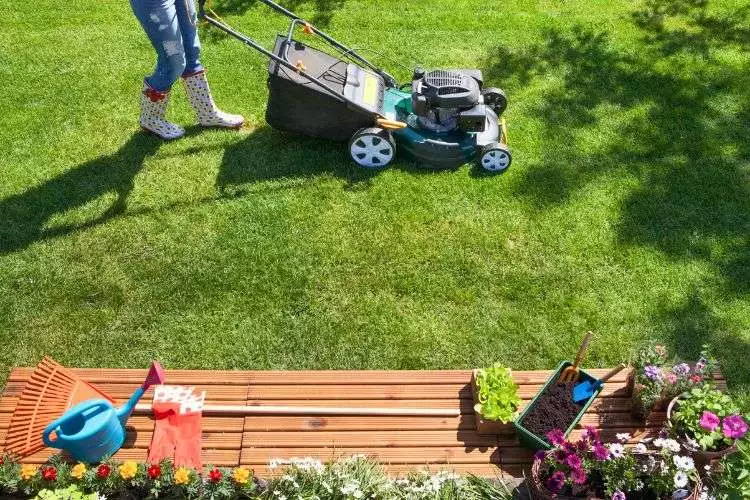
As much as our lawns need protection and care in high temperatures, we need to be just as diligent, if not more so, about safeguarding ourselves.
Before diving into specific strategies to ensure your safety while mowing in the heat, it’s essential to understand why this matter requires attention. After all, a heat-stricken gardener can’t maintain a garden, can they?
Staying hydrated
Hydration is the cornerstone of our well-being, especially when exerting ourselves in elevated temperatures. Our bodies lose fluids at an accelerated rate under the sun, and replacing this loss becomes paramount.
Importance of Water Breaks
- Body Temperature Regulation: Water aids in regulating our body temperature. As we sweat, our bodies use this mechanism to cool down. If we’re dehydrated, we sweat less efficiently, making it harder to regulate our temperature and increasing the risk of heat-related illnesses.
- Muscle Function: Dehydration can lead to muscle fatigue. When mowing, especially using a push mower, our muscles are continuously engaged. Staying hydrated ensures they function optimally, reducing the risk of strains or cramps.
- Mental Alertness: Dehydration can cloud our judgment, making us less alert. Regular water breaks not only keep us physically in check but mentally sharp, ensuring we make safe decisions while operating machinery.
Wearing appropriate clothing and sunscreen
Protecting your skin from the sun’s harsh rays isn’t just about avoiding a painful sunburn—it’s about long-term health and reducing the risk of skin-related issues.
- Clothing: Light-colored, loose-fitting clothing is ideal. Light colors reflect the sun, reducing heat absorption, while loose-fitting attire promotes better air circulation, helping to cool the body. Consider wearing a wide-brimmed hat to shield your face and neck, and sunglasses with UV protection to guard your eyes.
- Sunscreen: Even on cloudy days, up to 80% of the sun’s harmful UV rays can penetrate your skin. Apply a broad-spectrum sunscreen with an SPF of 30 or higher to all exposed skin, and reapply every two hours, or more often if you’re sweating profusely. Remember, sunburn doesn’t just cause discomfort—it increases the risk of skin cancer.
Recognizing signs of heat-related illnesses
Understanding and recognizing heat-related illnesses can be a lifesaver, literally. The body usually cools itself through sweating, but during intense heat, this might not be enough, leading to heat illnesses.
Heat Exhaustion vs. Heat Stroke
- Heat Exhaustion: This is a precursor to heat stroke and should be taken very seriously. Symptoms include heavy sweating, weakness, clammy skin, a weak pulse, nausea, or fainting. If you notice these symptoms, it’s crucial to move to a cooler location, sip water, and apply cool, wet cloths to as much of your body as possible.
- Heat Stroke: This is a severe condition that happens when the body can’t regulate its core temperature. Symptoms include high body temperature (above 103°F or 39.4°C), rapid pulse, throbbing headache, dizziness, or confusion. If these signs are present, 911 should be called immediately. While waiting for emergency personnel, move the person to a cooler place and try to reduce their body temperature with cool cloths or a bath.
Setting time limits for mowing sessions
It’s tempting to get the job done in one go, especially if you’re a perfectionist about your lawn. However, prolonged exposure in high temperatures can escalate the risk of heat-related illnesses. Here are some strategies:
- Mow in Intervals: Instead of mowing the entire lawn at once, consider breaking it up into sections and tackling a section at a time with breaks in between.
- Use a Timer: Set a timer to remind yourself to take breaks. For example, after every 20-30 minutes of mowing, take a 10-minute break in the shade and hydrate.
Alternatives to mowing on extremely hot days
Sometimes, it’s just too scorching to mow. On these days, consider these alternatives:
- Postpone the Task: If possible, delay mowing until the weather cools down, especially if rain is in the forecast which can naturally cool things down.
- Opt for Early Morning or Late Evening: These times are cooler, and you’ll avoid the midday sun. Remember to wear appropriate gear for visibility if mowing during dusk.
- Consider Lawn Alternatives: If consistently hot weather is a challenge, think about xeriscaping or using ground covers that don’t require frequent mowing.
By being aware of the potential dangers and setting boundaries for yourself, you can ensure that your quest for a pristine lawn doesn’t come at the cost of your health.
Alternatives to mowing in hot weather
Maintaining a lush, green lawn during hot summer months is often a challenge. Mowing under the blazing sun isn’t just tough on you; it can also stress your grass. Here are some savvy strategies to consider when the temperature soars.
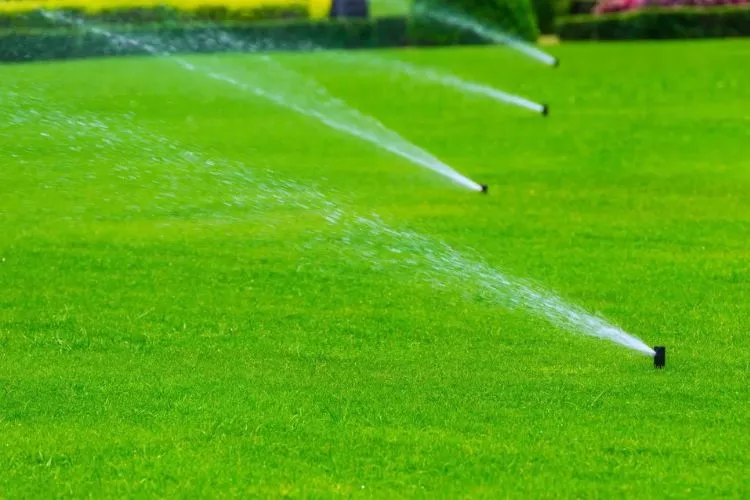
- Water the Lawn Before Mowing: Pre-watering your lawn can make a world of difference. A well-hydrated lawn is less likely to get damaged by the mower’s blades. Moreover, dampening the ground can cool the grass slightly, making it more resilient against the heat. Aim to water early in the morning so the lawn has time to absorb the moisture before the intense heat sets in.
- Raise the Mower Deck: Instead of giving your lawn a close shave, consider raising the mower deck. Longer grass blades provide shade to the soil, reducing evaporation and helping the ground retain moisture. This can also protect the soil from the direct heat of the sun, maintaining a cooler environment for the grassroots.
- Mulch the Grass Clippings: Instead of bagging and disposing of your grass clippings, let them lie. As they break down, they act as a natural mulch, aiding in moisture retention and providing essential nutrients back to the soil. This not only benefits the health of your lawn but also reduces the need for frequent watering.
- Hire a Professional Lawn Care Service: If the heat becomes too unbearable or you’re concerned about the best practices in extreme temperatures, it might be worth investing in a professional lawn care service. They have the expertise and equipment to maintain your lawn without causing heat-related stress to it—or you.
Frequently Asked Questions (fAQs)
Can I mow during a heatwave if my lawn desperately needs it?
Yes, but mow during the cooler parts of the day (early morning or late evening) to reduce stress on both the grass and yourself.
What are the risks of mowing in extreme heat for my lawn’s health?
Mowing in extreme heat can stress grass, causing browning, inhibit root growth, and increase vulnerability to pests and diseases.
How can I protect myself from heat-related illnesses while mowing?
Stay hydrated, take frequent breaks, wear lightweight clothing, use sunscreen, and mow during cooler times of the day.
Are there specific grass types that tolerate extreme heat better than others?
Yes, warm-season grasses like Bermuda, Zoysia, and St. Augustine are more heat-tolerant than cool-season varieties.
What are the benefits of adjusting the mowing height during hot weather?
Higher mowing height shades soil, reduces water evaporation, encourages deeper roots, and provides resilience against the heat.
Conclusion
In summary of the question “Is 90 degrees too hot to mow?”, temperature plays a crucial role in both lawn health and mowing practices. Extreme heat can adversely affect grass, making it vital to adjust mowing routines and prioritize lawn hydration.
Personal safety is paramount; wearing appropriate attire and recognizing heat-related illness signs can prevent severe health issues.
Always remember the importance of responsible lawn care during sizzling summer days. Prioritize both your well-being and that of your lawn. We hope that this guide has been helpful. You can read about similar topics here on our website. Check back again soon for more.


